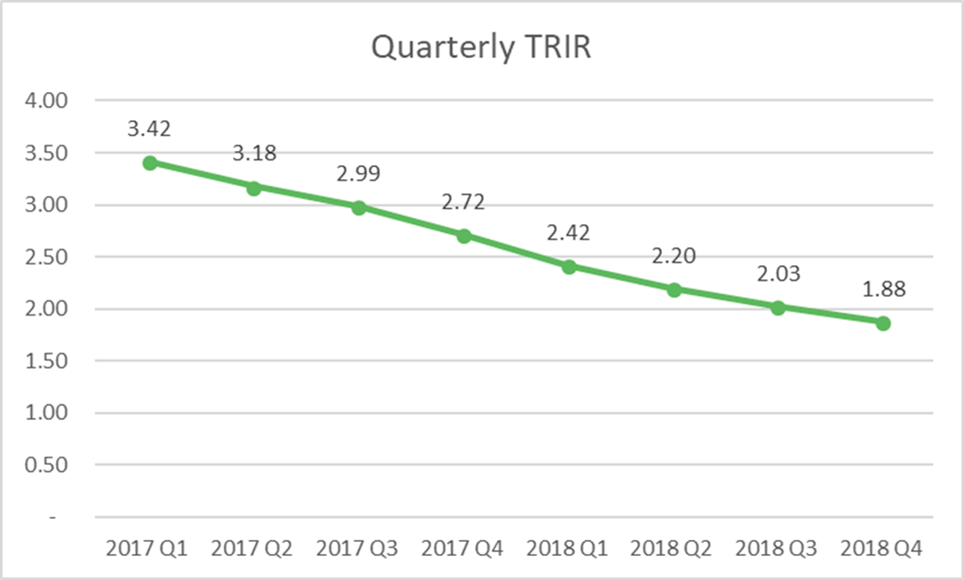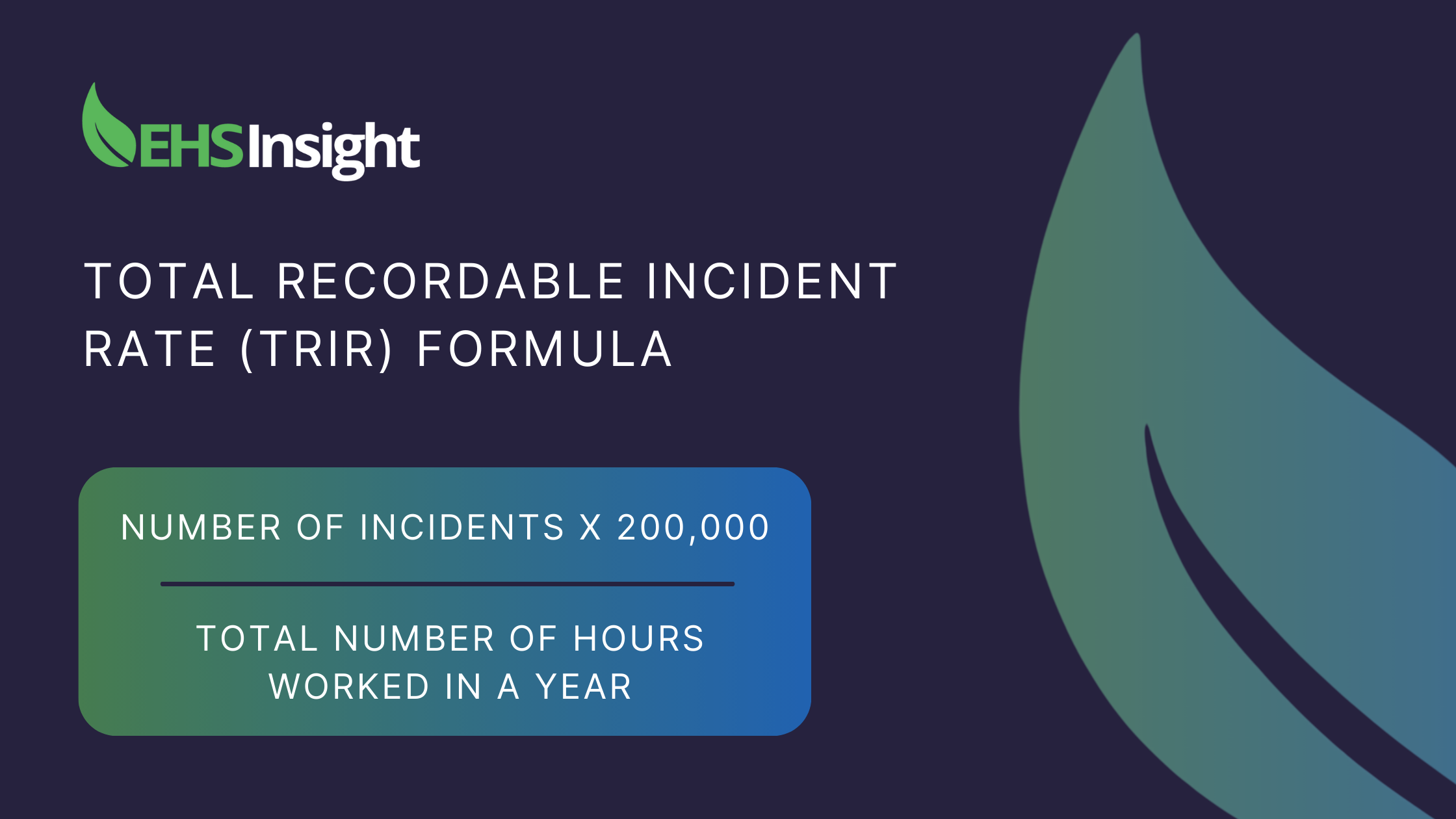Part of a successful EHS strategy depends on capturing the right metrics, and then knowing how to use those metrics to improve your EHS operations.
What is TRIR?
TRIR, or Total Recordable Incident Rate, is a metric devised by OSHA to assess a company's safety performance compared to its industry counterparts. It evaluates the frequency of recordable incidents per 100 full-time workers annually.
Why Is the Total Recordable Incident Rate Metric Important?
TRIR gives you direct insight into your company’s past safety performance. But your internal EHS department isn’t the only one interested in this particular metric.
If your TRIR scores are poor, it may lead to an uptick in surprise OSHA inspections and penalties. In addition, OSHA may increase their oversight in your company’s EHS programs.
Your insurance company may use TRIR data to determine your premiums. The higher your recordable incident rate, the more you could be paying for insurance.
Prospective employees may investigate your company’s safety performance, including TRIR scores. A high TRIR could signal a company’s lack of focus on employee safety and become a potential barrier to talent sourcing.
In addition, companies considering you as a vendor may be put off by a high TRIR score. They may see a business with a lower TRIR score as more favorable because it’s a testament to their safety record.
Given its impact across multiple channels of your business, it’s important you not only understand how to calculate your TRIR, but also how to keep this score as low as possible.
.png?width=559&height=314&name=TRIR%20Formula%20(2).png)
How to Calculate Total Recordable Incident Rate
OSHA uses TRIR, among several other methods, to gauge a company’s safety performance. The resulting calculation reflects the number of recordable injuries per 100 full-time workers during a one-year period.
TRIR looks at the number of total recordable incidents and compares it to the number of total hours worked by all employees in a single year. In this case, a recordable incident is any work-related injury and illness that result in death, loss of consciousness, days away from work, restricted work activity, transfer to another job, or medical treatment beyond first aid.
Here is the TRIR calculation formula set forth by OSHA:
TRIR = Number of Incidents x 200,000 / total number of hours worked in a year
The 200,000 is the benchmark established by OSHA because it represents the total number of hours 100 employees would log in 50 weeks based on a 40-hour work week. Two things to remember when totaling your annual work hours are:
- Vacation hours and leave hours (like FMLA leave, military leave, bereavement leave, etc.) should not be included in the “total work hours” calculation. Only actual hours worked can be included.
- If your company uses workers from a staffing or temporary agency and their day-to-day work activities are directed by your employees, their work hours must be included in your total hours worked.
 |
| TRIR showing a downward trend. |
So, if your total number of recordable incidents for the year is 4 and the total number of hours worked for your company is 425,030, then your formula would look like this:
4 x 200,000 / 425,030 = 1.88
In this example, the TRIR is 1.88.
How to Use TRIR to Make a Positive Impact
The health and safety of your workforce should always remain a core focus, and ensuring your business maintains a safe work environment is a large part of this effort.
If your company is using safety management software, you will likely have your company-wide safety data already stored in your central knowledge management system. Having this information readily available in the event of an OSHA inspection can lend credibility to your efforts to maintain a low TRIR.
In addition, using EHS software to track your TRIR score and other parts of your EHS program can help you determine a potential problem before it earns attention from OSHA. You get a better idea of your safety performance and can make adjustments as you go.
3 Ways to Lower Your TRIR
The business of managing safety programs at work is a lot like what’s happening in the medical world: both industries have taken a more holistic view of keeping people safe and well.
In both cases, that translates into a more integrated perspective with a focus on prevention. For companies interested in lowering their TRIR, the key to prevention lies in the collection and analysis of massive amounts of data.
That simply wasn’t possible just a few years ago, but with today’s new breed of advanced EHS software, it’s not only possible—it’s painless, enjoyable and effective. But even the best software in the world can’t compensate for an environment that’s not conducive to safety. With that in mind, here are three ways to lower your TRIR.
1. Determine Your Safety Culture
This involves some Big Picture thinking, but basically you want to pinpoint the collective attitude towards workplace safety at your company. Ask these questions:
- Are we thinking about how to prevent accidents?
- Is everyone motivated to report near misses and first aids?
- Is management prepared to handle reports of safety gaps?
- Is everyone on board with the idea of preventing incidents before they happen?
- How do we view safety? Is it the safety person’s job or does everyone participate?
2. Lock onto a Solid Incident Investigation Process
When incidents occur, you’ll want to already have a secure process in place for an effective investigation. Managers as well as front line workers and everyone else should know what steps to take in order to ensure all the right data and safety metrics get collected in the right way.
3. Incident Review and Correction
If an incident does occur, it’s important to handle it correctly, but even more important to learn from it. If you have solid records and a firm command of how events play into recordable incidents, you can prevent future incidents.
To see how EHS Insight can help you monitor and achieve a better TRIR score, request a free trial of our all-in-one EHS software solution today.
